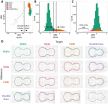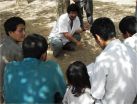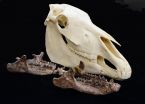(Press-News.org) ST. LOUIS, MO – OCTOBER 8, 2014 – What could the natural diversity and beauty of plant leaves have in common with one of mankind's greatest creative inventions, the violin? Much more than you might imagine.
"There are many parallels between leaves and violins," says Dan Chitwood, Ph.D., assistant member, Donald Danforth Plant Science Center in St. Louis, Missouri. "Both have beautiful shapes that are potentially functional, change over time, or result from mimicry. Shape is information that can tell us a story. Just as evolutionary changes in leaf shape inform us about mechanisms that ultimately determine plant morphology, the analysis of cultural innovations, such as violins, gives us a glimpse into the historical forces shaping our lives and creativity."
As a plant biologist, Chitwood spends most of his time exploring genetic and molecular mechanisms underlying diversity in plant morphology, or in layman's terms, understanding how leaf shapes are formed and what that means for a plant to grow and thrive. He also studies how leaf shapes change as plant species evolve to adapt in different environments. Research into why a desert-adapted tomato species can survive with little water, for example, sheds light on how leaf architecture affects the efficiency of plant water use.
Chitwood's research involves the tools of "morphometrics", which can be used to quantify traits of evolutionary significance. Changes in shape over time provide insight into an object's function or evolutionary relationships. A major objective of morphometrics is to statistically test hypotheses about the factors that affect shape.
But his love of music, and his talent playing the viola, led Chitwood to ask how musical instruments, particularly those designed by masters, evolved over time. Could shapes of violins tell us something about the function of the instrument, or about which violin makers (luthiers) borrowed ideas from others? Could the factors influencing violin evolution be analyzed and understood using the same morphometric approaches used to understand evolution of natural species?
Violin shapes have been in flux since the design and production of the first instruments in 16th century Italy. Numerous innovations have improved the acoustical properties and playability of violins. Although the coarse shape of violins is integral to their design, details of the body outline can vary without significantly compromising sound quality.
Chitwood compiled data on the body shapes of more than 9,000 violins from over 400 years of design history using iconography data from auction houses. The dataset encompasses the most highly desirable violins, and those of historical importance, including violins designed by Giovanni Paolo Maggini, Giuseppe Guarneri del Gesù, and Antonio Stradivari, as well as Stradivari copyists Nicolas Lupot, Vincenzo Panormo, and Jean-Baptiste Vuillaume.
The results of Chitwood's research were published in the article, "Imitation, genetic lineages, and time influenced the morphological evolution of the violin," in the October 8th edition of the journal, PLOS ONE.
Chitwood found that specific shape attributes differentiate the instruments, and these details strongly correlate with historical time. His linear discriminant analysis reveals luthiers who likely copied the outlines of their instruments from others, which historical accounts corroborate. Clustering images of averaged violin shapes places luthiers into four major groups, demonstrating a handful of discrete shapes predominate in most instruments.
As it turns out, genetics also played a role in violin making. Violin shapes originating from multi-generational luthier families tend to cluster together, and familial origin is a significant explanatory factor of violin shape. Together, the analysis of four centuries of violin shapes demonstrates not only the influence of history and time leading to the modern violin, but widespread imitation and the transmission of design by human relatedness.
As with all scientific papers, Chitwood's article was rigorously peer-reviewed, in this case, by some of the world's leading morphometrics experts. The critiques prior to publication led to improvements in the morphometric techniques used in the final analyses. Chitwood is now applying his improved methods to his plant research program at the Donald Danforth Plant Science Center.
"This is a fantastic example of how advances in one field can help advance a seemingly unrelated field," said Chitwood. "I'll be a happy scientist and musician if by understanding violin evolution this helps lead to improved crop plants that are more productive and sustainable."
INFORMATION:
About The Donald Danforth Plant Science Center
Founded in 1998, the Donald Danforth Plant Science Center is a not-for-profit research institute with a mission to improve the human condition through plant science. Research aims to feed the hungry and improve human health, preserve and renew the environment and position the St. Louis region as a world center for plant science. The Center's work is funded through competitive grants and contract revenue from many sources, including the National Institutes of Health, U.S. Department of Energy, National Science Foundation, U.S. Department of Agriculture, U.S. Agency for International Development, the Bill & Melinda Gates and Howard G. Buffett Foundations. To keep up to date with Danforth Center's current operations and areas of research, please visit, http://www.danforthcenter.org, featuring information on Center scientists, news, and the "Roots & Shoots" blog. Follow us on Twitter at @DanforthCenter.
Gamma rays are the highest-energy form of radioactive waves known in the universe. However, how they're made and where they come from have been a bit of a mystery.
But now a team of researchers, led by Michigan State University astronomer Laura Chomiuk, has made a discovery that may shed some light on the subject.
Using highly detailed radio telescope images, Chomiuk and her team have pinpointed the location where an explosion on the surface of a star, known as a nova, emitted gamma rays.
This, said Chomiuk, is something they did not expect to encounter.
"We not ...
In western society, where keeping up with the Joneses — or, better yet, surpassing them — is expected and even encouraged, status matters. So important is it that for many people, physical and emotional wellbeing are directly connected to their place in the social hierarchy.
That's hardly news to anthropologists at UC Santa Barbara, but they were taken by surprise when research findings indicated that the same relationship exists among the Tsimane, an egalitarian society of forager-farmers in the Bolivian Amazon. Their work is published online in the journal ...
The Northern Indian Ocean has awakened after a tropical slumber and created Tropical Storm Hudhud on Oct. 8 and NASA's Aqua satellite passed overhead.
The Atmospheric Infrared Sounder or AIRS instrument that flies aboard NASA's Aqua satellite passed over Tropical Cyclone Hudhud on Oct. 8 at 6:53 UTC (2:53 a.m. EDT and captured infrared data on the storm revealing bands of strong thunderstorms around the center.
Animated infrared satellite imagery showed that the low-level circulation center was consolidating, and there is an improvement in the banding of thunderstorms ...
TORONTO, October 7, 2014 – Health technology company Infonaut, a MaRS client, has released a study showing that hospital patients may be at significant risk of infection due to their own poor hand hygiene. The findings were measured in a Toronto hospital using Infonaut's Hospital Watch Live™ system, innovative technology designed to assist hospitals in monitoring and controlling the spread of infections by analyzing the movement and behaviour of hospital staff, patients and equipment.
The study found that patients on average washed their hands only 30% of the time ...
Researchers at Children's Hospital Los Angeles (CHLA) have described for the first time a specific perceptual learning deficit in mice with a mutation of the same gene as found in children with Fragile X Syndrome (FXS). Their findings, published on October 8 by PLOS ONE, may offer an effective pre-clinical platform for both investigating how brain circuitry is altered in FXS and testing drugs to improve these symptoms in children.
FXS is the most common inherited form of mental impairment, affecting an estimated 1 in 4,000 males and 1 in 6,000 females. Symptoms include ...
Four families likely influenced violin shape over four centuries, with many imitating famous designs like Stradivarius, according to a study published October 8, 2014 in the open-access journal PLOS ONE by Daniel Chitwood from Donald Danforth Plant Science Center in Missouri.
The first violins appeared in 16th century Italy and since then, their designers have continued to incorporate numerous innovations to improve the acoustical properties and playability of violins. However, details of the body outline can vary without significantly compromising sound quality and may ...
The discovery of new bones from a large land mammal that lived about 48 million years ago has led scientists to identify a new branch of mammals closely related to modern horses, rhinos, and tapirs, according to a study published October 8, 2014 in the open-access journal PLOS ONE by Lisa Noelle Cooper from Northeast Ohio Medical University and colleagues.
This family of large mammals, Anthracobunidae, is only known from India and Pakistan and was commonly considered to be ancestors of modern elephants and sea cows. Geographically, this was a puzzling idea, because elephants ...
Healthier foods and beverages have been consistently more expensive than unhealthier ones from 2002-2012, with a gap that's growing, according to a study published October 8, 2014 in the open-access journal PLOS ONE by Nicholas Jones from University of Cambridge, UK, and colleagues.
Governments have identified access to affordable healthy diets as a key factor in improving public health, yet methods for tracking prices of more and less healthy foods over time have not been established. The authors of this study analyzed existing government data on national food prices ...
For the first time, robotic prostheses controlled via implanted neuromuscular interfaces have become a clinical reality. A novel osseointegrated (bone-anchored) implant system gives patients new opportunities in their daily life and professional activities.
In January 2013 a Swedish arm amputee was the first person in the world to receive a prosthesis with a direct connection to bone, nerves and muscles. An article about this achievement and its long-term stability will now be published in the Science Translational Medicine journal.
"Going beyond the lab to allow the ...
CLEVELAND—Even before he lost his right hand to an industrial accident 4 years ago, Igor Spetic had family open his medicine bottles. Cotton balls give him goose bumps.
Now, blindfolded during an experiment, he feels his arm hairs rise when a researcher brushes the back of his prosthetic hand with a cotton ball.
Spetic, of course, can't feel the ball. But patterns of electric signals are sent by a computer into nerves in his arm and to his brain, which tells him different. "I knew immediately it was cotton," he said.
That's one of several types of sensation ...





